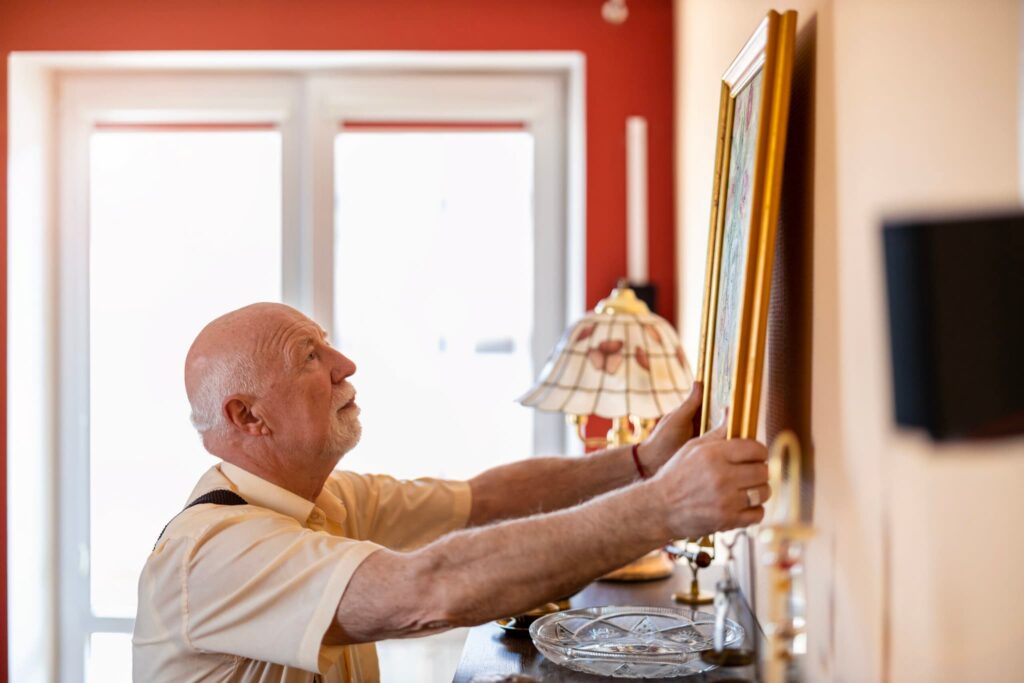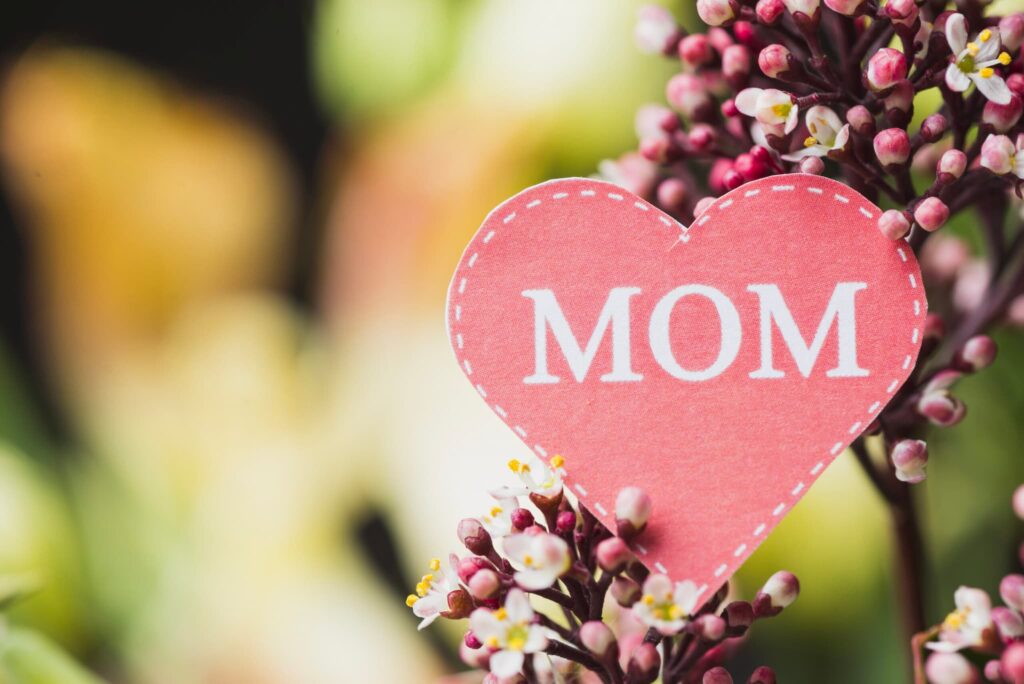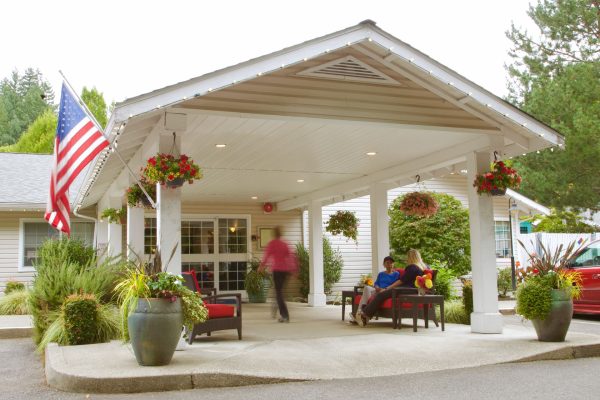
Helping Your Loved One to Downsize
If your loved one or family member is downsizing as they transition into an assisted living or memory care community, it’s time to start to declutter the home and organize piles to keep, sell, give, or donate. Here are a few helpful tips to get started:
Get Assistance. If your loved one is still living in their family home, your family will have years of memories and volumes of belongings to sort through. This can be a big job, so break it down into manageable smaller amounts of time. You don’t want to overwhelm your loved one into making too many decisions and feeling upset about the move. Schedule time on weekends and enlist the help of family and friends to help organize, make runs to the dump, list items to sell online, box up items to be moved, and make trips to charity drop-offs. The more hands to help, the quicker this daunting project can go. If the job of downsizing their house is too big, you can always hire help. An objective third party can help make tough decisions about what to keep and what to let go.
Design the New Space. Assisted living and memory care apartments are much smaller than a family home, so they should be decorated appropriately for the size and use. You don’t want to overcrowd an assisted living apartment for a senior when furnishings can become tripping hazards. Create a floorplan to see what will fit. Carefully measure their furnishings and the new space, most assisted living communities will provide a floorplan. Try to use multifunctional furniture, like an ottoman with storage. Keep pathways clear for walkers and wheelchairs. Remember, your loved one’s new home extends beyond their apartment with common areas and a dining room where they will eat their meals. Their apartment should feel comfortable, but they will be able to use the entire community throughout the day.

Make Four Boxes. If you have watched some of the popular decorating and organizing shows, you will see a tried-and-true method often used to declutter and downsize. Set up four boxes and label each of these: keep, trash, donate, and sell. Involve your loved one as you sort through their belongings. Pick up an item and help them to determine which box to place it in. Be patient, but try to decide then move on to the next item. If they are having a tough time making a choice, set an item aside, and move onto the next. This system may take a little time, but eventually, your loved one should be able to move through items more quickly. You may want to box up trash and donations before you end your session and get those moved out of the house to free up space and avoid the temptation to pull items out.
Be Sensitive. Involve your loved one throughout the process of sorting their belongings. Don’t lose sight that your parent is making a huge change in their life, and this process can be difficult for them. They may be sad, upset, nervous, and feeling a sense of loss. Even if they agree that the move is the best choice, this still may not be easy. Be understanding as you sort through their fond memories and personal items. It is surprising what may look like nothing to you, could have significant meaning for them. Give yourself and your loved one plenty of time to go through everything without exhausting or frustrating them in the process.
Don’t Keep Duplicates. We all do it. We see something on sale and pick up a few extras. But your loved one’s space will be limited. So, make a rule not to keep or move duplicates. You will want more than one set of items such as towels and bed linens. And they may want to have a small variety of dishes for their kitchenette. But try to streamline wardrobes, decorative items, and housewares to just their favorites. If there are duplicates, consider selling these online or giving to a family member to use in their home.
Think About Their New Lifestyle. In addition to a floorplan to see what furnishings fit also try to fit their new lifestyle. Will they be cooking? Do they have space for a second TV? Will they need space for a hobby? Most assisted living communities have dining rooms for meals and craft rooms for projects. The assisted living community may have a movie theater, so a second TV in your loved one’s apartment may not be necessary. Stay with the basics of what they will need and use every day. Keep furnishings simple for comfort and try not to overcrowd the space.
Spread Positive Energy. When sorting through belongings, try to keep the mood positive and light. Moving is stressful, but having to move because they can no longer live safely on their own can add even more stress to the situation. Give it a party atmosphere by playing music. Let your loved one share stories about their treasured items. Your family may even want to take notes and record why some of their items are special or the story behind them. Keep snacks and beverages on hand, so everyone is well-fed and happy.
See Progress. You may want to focus on one room at a time to see that you are making progress. A family home can be overwhelming, so start on the most essential rooms like the master bedroom, main bathroom, and living room. Having one room completed and checked off your list can make your loved one and family feel like you are making progress. This progress can also give them the energy to keep on moving or to trust that your family can continue on their own.
Find New Storage. Many adult children or grandchildren store boxes or personal items at a loved one’s house. Notify all family that your loved one is moving and set a date for them to pick up any of their personal belongings. Hopefully, family will be willing to move their items, otherwise toss or donate. You simply are not going to have the room for storage in their assisted living community.
Take Pictures. If your loved one is having a tough time parting with an item, you might suggest taking a picture. A thoughtful housewarming gift would be to take photos of their old home and objects and create a scrapbook or printed photo book for them to have in their new home. They can look back at these images at any time to remind them of their house.
Preparing to Move: Two Months Prior
At this point, you may not have made a final selection of where your loved one will move, but your family knows that they need to move, and you are actively looking. At the same time, you will want to start the process of downsizing. Decide in what order you will tackle the rooms and whom you can enlist to help in the process or if you need to hire outside assistance to declutter. Also, identify any family members who may be starting in their first home, newlyweds, or leaving for college. Your loved one may be more open to part with items if they know they will have a second life in a new home.
Two months ahead is a good time to start the process of eliminating duplicates, donating oversized furniture, and eliminating items that they will no longer need like a large turkey roasting pan, deep freezer, or outdoor furnishings. You may not know the exact floor plan of their new apartment, but you know they need to downsize. It is best to give yourself, your family, and especially your loved one the most time possible to sort and go through their belongings.
One important note, before you get too deep into the move and depending on how organized your loved one is, make sure to place all important financial and legal documents in safekeeping. You can scan and store these items or take these to your home for safekeeping. In the shuffle of moving, you don’t want to misplace these.
Preparing to Move: One Month Prior
At this point, you have made your choice for an assisted living or memory care community for your loved one. You have selected their apartment and can now work with a floorplan for what you can keep and what you won’t need to bring. It’s a good time to schedule help with friends and family to aggressively start downsizing and move from room to room. It might be time to schedule a moving sale or host a giveaway party to pick up items and visit your loved one before the big move. If you have a lot of items or large furniture, schedule a donation pick-up later in the month. Research moving companies if you do not have a way to transport their items to their new home and reserve a moving date. Or check with the assisted living community, they may have a partnership with a moving company. Order moving materials to pack items. And think about preparing and eating food in the freezer and pantry.
Preparing to Move: The Week Before!
You have almost made it! Finish packing and purging items this week. Notify their service providers and utility companies that your loved one is moving, including electric, trash, lawn service, internet, cable, and cell phone. With the house relatively empty, it is a good opportunity to start a deep clean, especially if you are planning to rent or sell the home. Take any final photos of the home, like the childhood height marks on a door frame that you cannot take with you. And check in on your loved one. They may be feeling sad or overwhelmed. Make sure they are comfortable and have what they need.
Assisted Living Checklist

Moving into an assisted living facility often means that your loved one will have to live on a smaller scale and narrow down what they need to bring. Here is your moving to assisted living checklist:
Personal Items
Set aside an essentials bag with a change of clothing, pajamas, medication, toiletries, and anything else they need for the first night of their stay. Just in case everything does not get unpacked, they have what they need immediately. Here are other personal items they will want to move into their new home:
- Toiletries
- Over the counter and prescription medications
- Photos and keepsakes
- Purse or wallet
- Sentimental jewelry or items worn daily like a watch
- Eyeglasses
- Hearing aid
- Cane, walker, or wheelchair
- Legal and financial paperwork (keep copies)
Furniture
Before you move, plan what furniture items will fit.
- Bed
- Side table and lamp
- Dresser
- Small sofa
- Recliner or chairs
- Table or desk
- Entertainment
Your loved one will have lots of activities to take part in but keep a few items for entertainment in their home.
- Television
- Computer
- iPad
- Chargers
- Audio system or radio
- Books
- Puzzles
- Playing cards
- Hobby supplies
- Clothing
Think about packing clothing that they will wear every day, which are casual and comfortable. Make sure clothing is all in good shape with no stains or needed repairs.
- Tops and bottoms
- Light sweater or sweatshirt
- Rain jacket or heavy jacket
- Hats, gloves, scarves
- Underwear and socks
- Pajamas
- Robe and slippers
- Comfortable shoes
Décor
To make the new apartment feel like home, decorate with personal items and photos.
- Plants
- Pictures
- Storage boxes and organization items
- Books
- Clock or alarm clock
- Mirror
- Housewares
Your loved one may be downsizing, but they may need a few small items for a small kitchenette or just to make an afternoon cup of coffee.
- Kitchen supplies
- Coffee maker
- Small selection of plates, cups, bowls, and mugs
- Towels
- Linens
- Hangers
- Hamper
- Small tool kit
- A grabber to reach high shelves
- Extended shoehorn
- Cleaning Supplies
Most assisted living communities provide both housekeeping and laundry services. But for small unexpected messes or quick clean-ups, keep a few items on hand.
- Broom and dustpan
- Surface wipes or multipurpose spray
- Stain removal stick
- Paper towels and kitchen towels
- Dish soap
- Pet Supplies
If your loved one is moving into assisted living with their pet, bring a few supplies so they feel at home too!
- Food and water bowls
- Pet bed and blanket
- Dog crate or cat litter box
- Food and treats
- Favorite toys
- Collar and/or leash
- Any pet medications

What Not to Pack
As you help your loved one or parent move to an assisted living community, their space will be smaller, and storage will be limited. You need to make sure the space works for their new lifestyle. And though it can be an arduous process to downsize, they will be happier in a small place with the right-sized items. Here are some of the items that we suggest that you avoid bringing:
- Oversized furniture
- Furnishings that are wobbly or in need of repair
- Decorative items that sit on the floor
- Glass-top tables
- Area rugs
- Duplicate items (i.e., bring a couple of favorite mugs and not an entire mug collection)
- Stained clothing or clothing in need of repair
- Chairs with wheels or without armrests
- Expensive or seldom worn jewelry
- Fancy outfits and dresses
- Limit the number of collectibles due to limited space
- Kitchen appliances, cutlery, and cookware
- Outdoor furniture and BBQ, unless their home has a small deck
- Boxes of stored items
Make the Move
If your family is interested in an Aegis Living assisted living or memory care community for your loved one, contact one of our communities near you. Our staff can help with packing and downsizing advice or assist your family with a smooth transition into their new home. Find a community near you.
Resources

Spend Father’s Day in an assisted living community
As you prepare to celebrate your father and all he means to your family, you may won...

Memorial Day: A Day of Honor
At Aegis Living, it has been our privilege and pleasure to care for many veteran...

Ready to Find Your Perfect Community?
See what Aegis Living has to offer near you! If you’re feeling overwhelmed, just give us a call and we’ll be happy to guide you.
Communities Nearby

Kent
10421 SE 248th St
Kent,
WA 98030

Issaquah
780 NW Juniper St
Issaquah,
WA 98027

Aegis Gardens (Newcastle)
13056 SE 76th St
Newcastle,
WA 98056